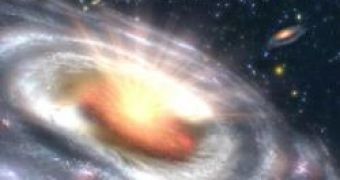Supermassive black holes, weighing several billion times more than the Sun, are widely believed to have begun their lives as smaller black holes that fed on the large masses of gas surrounding them. Computer models however tell another story. Small black holes cannot feed and grow rapidly to super-size because there's not much to feed on.
Supermassive black holes are usually found inside quasi-stellar objects, swallowing up gas at high rates. They can be found at large distances across the universe, some less than a billion years after the Big Bang event. The first stars in the universe were created only a few hundred million years after the Big Bang and even if stars one hundred times more massive than the Sun collapsed into a black hole a few million years later, there would still not be enough time to grow in mass several tens of million times.
A computer model created by Tom Abel and his colleagues from Stanford University, simulating the first generation of stars, shows that even a star 300 times more massive than the Sun would not have been enough to explain how supermassive black holes formed in the early universe. The amount of radiation generated during the star's life would have simply pushed all the surrounding gas away from it. So when the star collapses into a black hole, it has nothing to feed on to gain weight.
The simulation shows that it would have taken about one hundred million years or more before gas fell back into the black hole to feed it, leaving only a few hundred million years' time for the black hole to grow into an object billions of times heavier than the Sun.
"These are not progenitors for supermassive black holes as far as I can tell", said Abel in a conference last week at the Harvard-Smithsonian Center for Astrophysics in Cambridge.
Researcher Volker Bromm from the University of Texas agrees, although he also points out that if a black hole between 1000 and 1 million times more massive than the Sun formed from a collapsing cloud of gas, it could then grow to several billion solar masses in a short amount of time.

 14 DAY TRIAL //
14 DAY TRIAL //